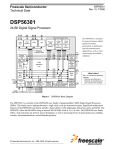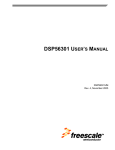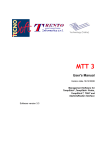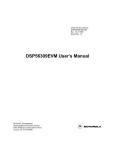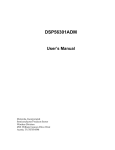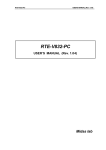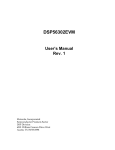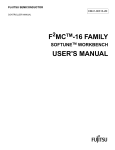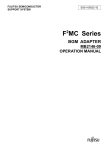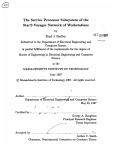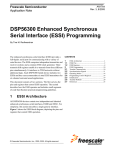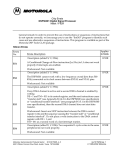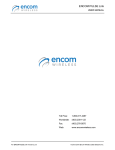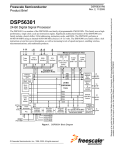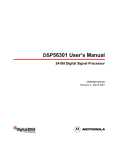Download PCI INTERFACE BOARD
Transcript
PCI INTERFACE BOARD This User’s Manual describes the PCI interface board product number ARC-63, Revision 3B, dated 10/25/99. The board is designed to install in a Peripheral Component Interconnect bus that supports 32-bit, 33 MHz operation. A 3.3 volt power source to the board is not required. The board is clasiffied as a short card, measuring 174.6 mm in length and 106.7 mm in width (4.20 x 6.875 inches), including the edge connector, which has 124 pads. In the language of the PCI specification, the board receives commands and parameters from the host computer as a target and writes image and reply data to the host computer as an initiator, which is analogous to a DMA controller. A Motorola DSP56301 manages the on-board resources and serves as the PCI bus controller. The interface board communicates to the controller over a fiber optics link. On-board memory consists of a small, fast FIFO memory and a large, slower DRAM bank, both used for buffering incoming fiber optics data. Additional memory consists of a boot EEPROM and memory internal to the DSP. Figure 1 shows a block diagram of the board. Fiber Rx Fiber Optic (50 MHz) Receiver 8M X 24 bit DRAM2 8M x 24 bit DRAM0 Clock Recovery 8M X 24 bit DRAM3 PCI Edge Connector Clock, Data Serial-Parallel Converter DRAM Controller DSP56301 1k x 18 bit FIFO D0-D17 Port A 4096 x 24 bit P: RAM 2048 x 24 bit Fiber Tx (4 MHz) Fiber Optic Transmitter Ext. Reset D0-D15, clock RS-232 Tx, Rx X:RAM Misc. 26-pin 33 MHz Control AD0-31 2048 x 24 bit Y:RAM LEDs Ext. Sync Ext. LEDs (2) ESSI0 PCI Interface D0-D17 Parity Connector Boot EEPROM 8k x 8 bit OnCE port Power ON Reset Software Reset Fig. 1 - Block diagram of the PCI interface board. PCI Interface Board, pg. #1 Updated Dec. 2, 1999 Several documents and software packages are provided by Motorola that may be of interest to the user. These are all available on the DSP website, accessible from www.mot.com. Several of the most useful documents have been copied here, including the DSP56300 Family Manual (FamilyManual.pdf), the DSP56301 User’s Manual (UsersManual.pdf), and the PCI application note AN1780 (PCI.pdf). Reference to these manuals will be made in this document. Circuit Description The DSP56301 operates at 3.3 volts, whereas the fiber optic parts operate at 5 volts. Toaccomodate the two voltage requirements a 5 volt to 3.3 volts regulator is installed on the board, and only 5 volt power is drawn from the edge connector. Several parts the EEPROM, FIFO and DRAM) were chosen in their low voltage option. Two Cypress CY7C372I PALs operate from both 3.3 and 5 volt supplies and have inputs that tolerate 5 volts and outputs that reach a maximum of 3.3 volts, providing a simple interface between 3.3 and 5 volt parts. The DSP is driven from the 33 MHz PCI bus clock, and employs an internal phase locked loop (PLL) to multiply the input clock to its internal operating frequency of 78.4 MHz, s described in Section 2.1 of PCI.pdf, as follows PLL_INIT EQU $750012 MOVEP #PLL_INIT,X:PCTL ; PLL = 33 MHz x 19 / 8 = 78.4 MHz ; Initialize PLL The DSP boots from a 8k x 8 bit on-board EEPROM (Catalyst part number CAT28LV64P, any speed) that operates at 3.3 volts. When the DSP RESET* signal makes a low to high transition the input lines MODD to MODA are set to a 0001 by PAL U23 to cause the DSP to execute an internal program that reads the DSP program from the EEPROM, and starts executing it from program address zero. The RESET* line may be asserted low true by the host computer’s assertion of the PCIRST* line if the jumper JP11 is installed. The Sun Microsystems Ultra 5 used for the interface board development asserted this signal only during the power-up sequence and correctly released it several seconds prior to accessing the interface board during the booting process. For host computers whose PCIRST* line may not be well defined the jumper JP11 should be removed and booting accomplished instead from a power-on reset circuit that asserts the RESET* line for several hundred milliseconds after the 5 volts power has been turned on. All DSP code executes from memory internal to the DSP, which must be loaded with the desired code. There are three mechanisms for doing this. The boot code written to the EEPROM is generated with a short script named "rom" that assembles and links a DSP source code file named "pciboot.asm" written in assembly language with the assembler parameter DOWNLOAD=ROM to generate a Motorola S-record file named "pci.s" that is loadable into an EEPROM burning machine. The script "host" sets DOWNLOAD=HOST to generate a file named "pci.lod" that can be downloaded via the host over the PCI bus to the DSP. The script "once" sets DOWNLOAD=ONCE to generate a file named "pci.lod" that can be loaded into the DSP with the OnCE in-circuit emulator facility that Motorola provides. The DSP source code file "pciboot.asm" has several conditional assembly directives at the beginning to set execution and EEPROM load addresses to certain values depending on the DOWNLOAD parameter, and to follow the protocol of the three different solftware loading mechanisms. To summarize - PCI Interface Board, pg. #2 Updated Dec. 2, 1999 script name rom host once DOWNLOAD ROM HOST ONCE Output file pci.s pci.lod pci.lod Start Adress P:INIT_PCI P:START P:START Functionality Program the EEPROM externally Download via host computer Load via OnCE emulator The beginning of the file "pciboot.asm" contains two routines located in an unused portion of the vectored interrupt table. The first of these, INIT_PCI, initializes the DSP’s PCI controller, and is executed only when the board boots from EEPROM on power-on. A few seconds after power on the host computer interrogates the PCI bus to find out what boards are installed and configures this inteface board. The booting procedure ends with program execution starting at address P:0, where the EEPROM program inserts a JMP INIT_PCI instruction. INIT_PCI sets the phase lock loop parameter as described above and does a self-configuration and personal software reset of the PCI controller in the DSP, as described in Section 2.2 of PCI.pdf. After configuring the PCI controller the DSP program overwrites the instruction at P:0 with JMP START to skip over the INIT_PCI routine, where the START address begins configuring the DSP and processing commands. Similarly, the "host" and "once" options place a JMP START instruction at P:0 to skip over the PCI_INIT routine. Executing the INIT_PCI routine after the host computer has booted will cause the host computer to crash since the host computer overwrites the configuration registers with its own values and doesn’t tolerate foreign values. The second routine is for downloading the file "pci.lod" generated with the script "host" to the DSP via the PCI bus of the host computer. This is useful to allow development of interface board software in the same machine as its being executed, and to download different software versions than are resident in the ROM. The routine is labeled DOWNLOAD_PCI_DSP_CODE and uses DSP software that is resident in DSP ROM for loading DSP code over the PCI bus, as described in Appendix A of the User’s Manual. The PCI interface of the DSP is first placed in a mode where it does not insert PCI addresses in the data stream (IAE=0, described below) and a sanity word is read from the PCI bus to establish communication. The Operating Mode Register OMR is then set to $00000C to cause the PCI loading software to be executed once the program jumps to the program resident in the DSP starting at location $FF0000. The first two words of the file "pci.lod" contain the number of DSP words to be loaded and the starting load address, which is also the address where the loading routine jumps to after it is finished. These two words are set in the "pciboot.asm" file in the assembler directives; the starting address is set to zero and a jump to the INIT routine is placed there so that the PCI self-configuration and download DSP software will not be executed. Care should be exercised not to modify the INIT_PCI and downloading routines when downloading DSP code because an error introduced in either of them will necessitate the host computer being re-booted so correct software can be loaded from the EEPROM. The "once" script allows for the DSP to be loaded from the On Chip Emulator (OnCE) port that Motorola has incorporated into the DSP. To use this port a Command Converter is connected via a small ribbon connector to the OnCE connector on the interface board, and another ribbon cable is connected between the Command Converter and a Motorola-supplied interface board in a Sun, PC or Mac. These are marketed in the ADS, or Advanced Development System, line of products, and are described in the Motorola Web site. A program on the computer hosting the ADS can read the "pci.lod" file produced by the "host" script and load it into the DSP. This is particularly useful if PCI Interface Board, pg. #3 Updated Dec. 2, 1999 extensive DSP code development is done by the user since the ADS incorporates many useful development tools such as breakpoint insertion, and register, memory and program inspection, program assembly and disassembly. All the interface board software development was done in this mode. A software reset button is located on the front panel of the PCI interface board. It does not assert the hardware RESET* line to the DSP, which is only asserted on power-up, but rather asserts the interrupt line IRQC* that causes the DSP program to jump to an interrupt service routine that sets the program counter to the beginning of the program INIT and sets the stack pointer to the top of the stack. This switch can be used to get out of locked up DSP code without having to reboot the host computer. The switch on the board is OR’d with two pins from the external 26-pin connector so a switch external to the host computer can be installed by the user. Commands and parameters are transmitted to the controller timing board following the protocol discussed in the timing board User’s Manual. The data words are all 33 bits long, containing a start bit, a preamble bit (normally $AC, and $53 for resettting the timing board), and 24 bits of data. A fiber optic transmitter is connected directly to the clock and data output lines of the Extended Synchronous Serial Interface (ESS1) port 0 of the DSP, described in Chapter 7 of UserManual.pdf. It is programmed for a clock rate close to 4 MHz and 8-bit per word operation. The XMT_WRD routine transmits a byte at a time to the serial port data register, building up the start bit, preamble byte, data bytes and trailing zeroes explicitly in software. It samples the Transmitter Data Register Empty (TDE bit #6) of the ESSI0 Status Register before writing each byte to the transmitter Data register TX00. The port is configured by writing to the Control Registers CRA0 and CRB0, where only the two lines STD0 and SCK0 are configured as serial ports, the rest being used as general purpose I/O ports. The comments in the source code of "pciboot.asm" that set the CRA0 and CRB0 registers describe the port configuration. A bank of dynamic random access memory (DRAM) parts is implemented to buffer images should the host computer not be able to write images to user memory space fast enough to keep up with image data from the controller. It consists of a total of nine page mode 8Meg x 8 bit memories grouped into three memory spaces. Each group has common read, write and column access strobe signals generated by the DSP, and separate row access enable lines RASn*. A common DRAM control register DCR is programmed to the maximum time between refresh cycles, page logic enabled, and the appropriate page size and wait states for the DRAM memory installed, as described in Sections 9.2.2 and 9.6.1 of Family.Manual.pdf. The memory map to DSP space are controlled by the Address Attribute Register AAR0, AAR2 and AAR3, and are programmed as follows Date memory Y: $800000 to $FFFFFF asserts DRAM access with AA0/RAS0* Date memory Y: $000000 to $7FFFFF asserts DRAM access with AA2/RAS2* Data memory X: $000000 to $7FFFFF asserts DRAM access with AA3/RAS3* The memory spaces X:$0 to X:$000FFF and Y:$0 to Y:$000FFF are mapped to fast memory internal to the DSP. These Y: locations are used for buffering images, while the X: space is used for parameter storage and should not be overwritten with image data. Similarly the memory space at X:$FF0000 and Y:$FF0000 are reserved and should not be used for image storage. PCI Interface Board, pg. #4 Updated Dec. 2, 1999 The address line AA1 is mapped to two different places - it selects the EEPROM during power-on boot and also selects reading the buffer FIFOs after booting has taken place. During booting the signal ROM/FIFO derived from one of the general purpose I/O pins of the ESSI is in a default high impedance state held high by a pull up resistor, causing the PAL U14 to assert the EEPROM chip access signal CEROM* whenever AA1 is asserted. After booting the DSP program clears the line ROM/FIFO, which instead causes the PAL U14 to assert RDFIFO* whenever AA1 is asserted. The Address Attribute Register AAR1 is programmed to respond to accesses to data memory Y:$FFF000 to $Y:FFFFFF, so the memory location RFFIFO is simply set to $FFFFFF, and the simple instruction MOVEP Y:RDFIFO,X0 reads the FIFO contents into the data register X0. The FIFO is 18 bits wide and 1024 words deep, and is written to whenever a data word is received by the fiber optic receiver. The two most significant bits D16 and D17 are included for future handling of 18-bit images, and are currently ignored by the DSP software. The fiber optic receiver is implemented with the same 50 MHz parts that are on the timing board, and the same circuit. The fiber optic receiver generates an electrical data signal that the clock recovery chip uses to generate synchronized clock and data signals, with seven jumpers needed to select the frequency range of the incoming data. The table below shows the jumpering for 50 MHz systems (Gen II), 40 MHz (Gen I), and 4 MHz (for self testing). Neither self-testing nor support of Gen I operation has been implemented at the present time. Self-Test Gen I Gen II 4 MHz 40 MHz 50 MHz M0 open jumper jumper M1 open jumper jumper M2 jumper jumper jumper L0 open open jumper L1 open jumper jumper L2 jumper jumper jumper N jumper open open The data format for incoming data is either 32-bit mode for commands and replies or 16-bit mode for image data. The 32-bit mode follows the same format described above for data transmission, whereas 16-bit mode simply has one start bit preceeding the 16 data bits. In all cases the most significant bits are sent first. The LED below the reset switch is turned on when a valid fiber optic signal is received from the timing board. A serial-to-parallel circuit is implemented in the PAL U14 that converts incoming serial data either to two 16 bit entries in the FIFO (if MODE = 1) or a single entry in the FIFO for image data (MODE = 0). The PAL generates the write FIFO signal WRFIFO*. A signal named FSYNC* for frame synchronization is also generated following the same convention discussed in the timing board manual for adaptive optics applications. It is routed to the DSP, and could be routed to the external connector on special user request by re-programming the PAL. PCI Interface Board, pg. #5 Updated Dec. 2, 1999 The signal labeled AUX1 = SRD0 = PC4 is programmed as a general purpose I/O bit and is wired through the PAL U14 to the LED on the corner of the board and to the external connector. It can be manipulated by the user to indicate that data transfer is active, or for any other purpose. It is presently simply left off. There is a 26-pin, three row DB connector installed on the front panel of the board to support several input and output functions. The connectors are available from Newark, with the following part numbers Board connector, female, AMP 5120262 Cable connector, male, Amphenol 174D026PAA000 The connector pinout is given below Pin # 1 2 3 4 5 6 7 8 9 10 11 12 13 Function Output Data 1 Output Data 3 Output Data 5 Output Data 7 Output Data 9 Output Data 11 Output Data 13 Output Data 15 Input sync Output Data 0 Output Data 2 Output Data 4 Output Data 6 Pin # 14 15 16 17 18 19 20 21 22 23 24 25 26 Function Output Data 8 Output Data 10 Output Data 12 Output Data 14 Data Strobe = AA3 Serial Data Tx Serial Data Rx LED 1 LED 2 Switch normally open Switch normally closed 5 volts out Ground The Data Strobe is just the AA3/RAS3* pin also used for addressing the DRAM. IF it is needed as a data strobe for this application it cannot also be used for DRAM access and needs to be re-programmed by the user with the AAR3 register. Section 9.6.1 of FamilyManual.pdf describes how to program this register. The output data lines D0-D15 are buffered data lines from the DSP. The input synchronization signal is connected to the PAL U23. Presently this is wired in the PAL to the signal AUX3 that connects to the general purpose I/O pin PC0 and may be used for any input function. Alternatively, on special request the PAL can be re-programmed to generate an interrupt when the line is asserted to insure rapid response times. The Serial Rx and Tx lines are RS-232 signal derived from a SN75155 asynchronous driver chip connected to the synchronous communication interface (SCI) pins of the DSP. They allow bidirectional communication directly with the DSP for controlling or synchronizing with external hardware. Pads are included on the interface board for the user to install filter capacitors C44 and C45 on the +/- 12 volt power supply lines if they are noisy. The LED pin 1 is connected to the PAL output pin driving PCI Interface Board, pg. #6 Updated Dec. 2, 1999 the LED that indicates that the fiber optic receiver line has received a valid signal. The LED pin 2 is connected through the PAL to the DSP general I/O pin AUX1 = PC4 discussed above. The two pins for operating a switch can be wired to a remote switch that is more accessible than the one located on the board for software resetting during development sessions. Finally, +5 volts and ground are made available for powering any external circuitry that may the user may implement. PCI interface The PCI interface of the DSP56301 is described extensively in Chapter 6 of UserManual.pdf, and in the application note named PCI.pdf. An extensive set of register accessible from the DSP program and a smaller set of registers accessible from the host computer are used to control its operation. Below are described some of the implementation details of the supplied DSP program. Soon after booting the following code is executed to configure the PCI port: MOVEP NOP BSET BSET NOP #$100000,X:DCTR ; HI32 mode = PCI #MACE,X:DPCR #IAE,X:DPCR ; Master access counter enable ; Insert PCI address before data ; End of PCI programming Writing the indicated value to the DSP Control Register DCTR)configures the HI32 port as a PCI controller. Setting the Master Access Counter Enable MACE bit 18 in the DSP PCI Control Register (DPCR) enables the burst mode counter so more than one word can be written to the PCI bus after writing a single address. The Insert Address Enable IAE bit 21 being set causes the PCI address to be written before the data is written whenever the host computer writes to the DSP, allowing the DSP software to compute the DSP memory address where to put the data. This permits simple tables to be memory mapped between the host computer and the DSP. The PCI interface of the DSP contains a 6 x 24-bit FIFO for receiving data written by the host computer, called the DSP Receive Data FIFO DRXR. The DSP PCI Master control register DPMC has its bits 23-22 cleared on reset which sets the translation mode in transferring 32-bit PCI words to 24-bit DSP such that each PCI word gets read as two 16-bit DSP words, occupying two locations of the FIFO. Each word written to the interface board then occupies four of the six locations of the FIFO, two for the PCI address and two for the data. To ensure that the FIFO does not lose data from being overfilled the host computer must monitor the TRDY bit 0 in the Host interface Status Register HSTR for a one to be sure the FIFO is empty before writing to it. The DSP program monitors the Slave Receive Data Request SRRQ bit 2 of the DSP Status Register DSR to be set, which indicates that the host computer has written to the receive FIFO and can be read. The following lines of code reads 32 bits of the PCI word in two passes into the X0 and X1 register, then calls the SQUASH routine to compress it into a single 24-bit DSP register, losing the eight most significant bits in the process: JCLR MOVEP JCLR #SRRQ,X:DSR,* X:DRXR,X0 #SRRQ,X:DSR,* ; Wait for receiver to be not empty ; Get least significant word PCI Interface Board, pg. #7 Updated Dec. 2, 1999 MOVEP JSR X:DRXR,X1 <SQUASH ; Get most significant word ; Convert 2 x 16-bit PCI words in X0 and X1 into one 24-bit DSP word in A1 SQUASH MOVE X1,A LSL #16,A ADD X0,A RTS The DSP writes words to the PCI bus in a more involved procedure. The 16 least significant bits of the DSP PCI Master Control Register DPMC contain the 16 most significant bits of the PCI address to be written to. The bits 23-22 of the DPMC register specify that the DSP Master Transmit Data FIFO DTXM will write two of its 16-bit data words into one 32-bit PCI word, similar to how the receiver works. The burst length bits 21-16 are set to zero to write one word per address. The 16 least significant bits of the DSP PCI Address Register DPAR contain the 16 least significant bits of the PCI address to be written to. The DPAR bits 23-20 are set low to enable all four bytes, causing 32-bit words to be written to the PCI bus, while the PCI command in bits 19-16 are set to a 0111 to mean memory write. The 24-bit data word to be written is loaded 16 bits at a time to the DTXM if the Master Transmit Request MTRQ bit 1 of the DSP PCI Status register DPSR is set. Once the DPMC and DTXM register are loaded writing the value to the DPAR register initiates the write cycle onto the PCI bus, as the DSP makes a PCI bus arbitration request, receives a grant, asserts the desired PCI address on the multiplexed address/data lines AD31-0, after which the word is asserted on the same signal lines. Monitoring of the Master Address Request MARQ bit 4 of the DPSR is also done to ensure that the PCI bus is available for a new transaction. For writing image data the burst mode is enabled by setting the appropriate bits of the DPMC register, and image data is written as two 16-bit image pixels in a single 32-bit PCI word. JCLR MOVEP JCLR MOVEP #MTRQ,X:DPSR,* X0,X:DTXM #MTRQ,X:DPSR,* X1,X:DTXM ; Make sure the transmitter is not full ; Write least sig. word to transmitter ; Make sure the transmitter is not full ; Write most sig. word to transmitter JCLR MOVEP MOVE MOVE OR JCLR MOVE #MARQ,X:DPSR,* ; Wait for completion of PCI transaction X:REPLY_ADR_MSW,X:DPMC ; Get reply address most sig. word #$070000,A X:REPLY_ADR_LSW,X0 ; Get reply address least sig. word X0,A #MARQ,X:DPSR,* ; Wait for completion of PCI transaction A,X:DPAR ; Write word to PCI bus The DSP mask number (3F48S) currently available From Motorola does not calculate parity correctly, necessitating external circuitry to calculate it and insert it onto the bus when needed. A bank of four 9-bit parity chips sample the 32 multiplexed address/data lines AD00-AD31 and the four command bits C0-C3 and connect the results to the parity PAL U23 to calculate a net parity. The address parity PCI Interface Board, pg. #8 Updated Dec. 2, 1999 FO Test Points PAL U14 PCI Reset Fiber Optic Rx FO Speed 24M x 24 bit DRAM Serial-toParallel Fiber Optic Tx EEPROM 8k x 8 bit Reset OnCE FO OK Test Points PAL U23 DSP56301 Parity +3V Gnd +5V External 26-pin Connector ARC-63 1 2 ASTRONOMICAL RESEARCH CAMERAS, INC. PCI INTERFACE BOARD REV. 3B 10/25/99 Parity Select Fig. 2 - Layout of the principal components of Rev. 3B of the PCI interface board. is asserted on the PCI line PAR during the address phase if the interface board is the bus master as determined by sampling the bus grant line GNT*. The data parity is asserted during the data phase if a write cycle is underway, as determined by examining the command line C0, whether or not the interface board is the bus master or not. Motorola has promised that future mask revisions of this DSP will correct this flaw, but for now this workaround seems to work. Jumper Summary The principal components of the PCI interface board are shown in Fig. 2. The default jumper placements are shown in the figure. Three sets of jumpers select different operating modes FO Speed selects the frequency range of incoming fiber optic data, as described above. PCI Reset with a jumper installed connects the signal PCIRST* to the DSP RESET* line. Parity Select when installed to the left between pins 1 and 2 connects the on-board parity generation circuitry to the PCI parity line PAR. When the jumper is installed to the right between pins 2 and 3 PAR is generated by the DSP. PCI Interface Board, pg. #9 Updated Dec. 2, 1999











